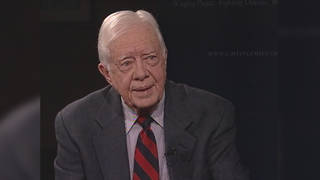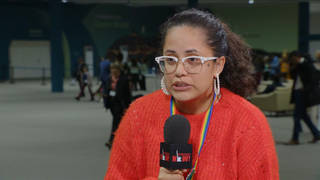
Related
Guests
- Tami Grahama fifth-generation Coloradoan and a professional mediator. She benefited from Obama’s Affordable Care Act by being able to qualify for health insurance when she was diagnosed with uterine cancer. In May 2012, Graham was chosen to introduce President Obama at a fundraising event in Denver.
When Colorado resident Tami Graham was diagnosed with stage 1 uterine cancer, she knew she could not afford the tens of thousands of dollars needed for treatment since she did not have health insurance. That is when someone mentioned the high-risk pools established by President Obama’s Patient Protection and Affordable Care Act. The insurance helped pay for Graham’s hysterectomy, as well as follow-up care. After Graham responded to the Obama campaign’s Facebook post seeking personal experiences with the Affordable Care Act, she was invited to introduce Obama at a Denver fundraising event. Graham joins us to talk about this underreported part of Obama’s healthcare plan that is designed as a bridge for people with pre-existing conditions who cannot obtain health insurance coverage. [includes rush transcript]
Transcript
AMY GOODMAN: We’re broadcasting from the Ballantine Media Center here at Fort Lewis College. It’s named after Richard Ballantine, who’s the publisher of the four regional newspapers here: the Durango Herald and the Mancos Times, the Cortez Journal and the Dolores Star.
Well, first lady Michelle Obama is scheduled to speak here at Fort Lewis College tomorrow at 6:00 in the afternoon, as the Democratic campaign seeks to woo voters here in the swing state of Colorado. Well, today we’re going to speak with a woman who was chosen to introduce President Obama when he spoke in Denver in May. She’s Tami Graham, fifth-generation Coloradoan, a professional mediator.
When Tami Graham was diagnosed with stage 1 uterine cancer, she knew she couldn’t afford the tens of thousands of dollars needed for treatment, since she didn’t have health insurance. That’s when someone mentioned the high-risk pools established by Obama’s Affordable Care Act. The insurance helped pay for Graham’s hysterectomy as well as follow-up care. After Tami responded to the Obama campaign’s Facebook post seeking personal experiences about the Affordable Care Act, she was invited to introduce President Obama.
TAMI GRAHAM: There I was, with cancer and without insurance. Through my local health department, I found out about a new program created by “Obamacare.” The name of that program was the Pre-Existing Condition Insurance Plan.
AMY GOODMAN: That was Tami Graham introducing President Obama in May. She also happens to have been, for years, the general manager of the community radio station here in Durango that airs Democracy Now!, KDUR. And she’s joining us now to talk more about this underreported part of President Obama’s healthcare plan that’s designed as a bridge for people with pre-existing conditions who can’t obtain health insurance coverage.
We welcome you to Democracy Now! It’s great to have you with us, Tami.
TAMI GRAHAM: It’s great to be here. Thank you.
AMY GOODMAN: So—and it’s great to see you in good health.
TAMI GRAHAM: Yeah.
AMY GOODMAN: What always amazes me, because I have friends who have discovered this program, what is more frightening sometimes than not having the program, that you can actually get insurance without—with a pre-existing condition, is that there is such a program but people don’t know about it.
TAMI GRAHAM: I was amazed. In the medical industry, not one person that I talked to in the last year actually knew about this pre-existing conditions plan insurance program. I was stunned. So—
AMY GOODMAN: In New York it’s called the Bridge program.
TAMI GRAHAM: OK.
AMY GOODMAN: But it has different names in different states?
TAMI GRAHAM: Yeah, here in Colorado, it’s called Getting US Covered. And it’s—it’s amazing. No one—no one knew about it. I thought, if anybody, the medical industry would. So, it’s great to be here to let people know about it.
AMY GOODMAN: So, tell us what happened. You’re diagnosed with cancer.
TAMI GRAHAM: I was diagnosed a year ago September, so 12, 13 months ago, much to my surprise. I’m very healthy. I’m fit, 47 years old, didn’t expect, by any means, to have a cancer diagnosis phone call. However, there I was. So I went ahead and started scrambling to figure out how I was going to pay for the treatments I needed, because I didn’t have health insurance. I’m self-employed. So, I called my local health department, and someone there—bless her soul—knew about the pre-existing conditions plan. She said, “Well, you might check this website, “http://www.gettinguscovered.org”>gettinguscovered.org.” And so I did. And, sure enough—
AMY GOODMAN: What’s the website?
TAMI GRAHAM: Gettinguscovered.org. And I was able to find out that I qualified. Basically, one just has to not have been covered by insurance for at least six months. You have to demonstrate that your employer can’t provide you with insurance, which I’m self-employed, so—can’t provide you with insurance because of your condition, pre-existing condition. So, that was easy to prove. And it was actually fairly easy to qualify and to get lined out. So, as of November 1st, I had coverage.
AMY GOODMAN: What’s so interesting, I find, about this program is that while insurance companies are famous for saying no to everything—
TAMI GRAHAM: Right.
AMY GOODMAN: —this one they accept, and they want you to get accepted to. So even if you get rejected, they encourage you to go to advocates to rewrite a very simple form, because they get fully reimbursed by the federal government.
TAMI GRAHAM: Right, right. So, it’s kind of amazing. I’m still kind of surprised that I was that easily able to get insurance coverage with a pre-existing condition, because you hear all the horror stories of, you know, people going bankrupt and whatever it might be because they can’t cover their medical costs in a situation like this.
AMY GOODMAN: So, you got the coverage, and then where were you able to go for treatment?
TAMI GRAHAM: I went—I was able to go to Anschutz Medical Campus, which is the CU-Boulder research hospital.
AMY GOODMAN: That’s Colorado University.
TAMI GRAHAM: Yeah, Colorado University, excellent hospital, got outstanding care, didn’t have to skimp on anything in terms of my care or follow-up treatment. So, I’m fortunate.
AMY GOODMAN: You know, what has been amazing, that this has been in effect for well over a year—
TAMI GRAHAM: Right.
AMY GOODMAN: —but that most people in this country have no idea. There’s still this thought that if you have a pre-existing condition, you might as well give up on getting any insurance.
TAMI GRAHAM: Right, absolutely. I mean, it’s—I had to—I’m still, like I said, shocked. And like you say, the vast majority of people I talk to, people have no idea that any part of the Affordable Care Act has gone into effect, much less this, in my opinion, one of the most important parts of the Affordable Care Act.
AMY GOODMAN: Well, I want to thank you very much for being with us, sending out that alert, information that could save many people’s lives.
TAMI GRAHAM: Absolutely. I mean, it could have saved mine, so I’m glad I didn’t have to stress about getting insurance at a time like that. So, thank you, Amy.
AMY GOODMAN: Tami Graham, and thank you for your work with community radio—
TAMI GRAHAM: You’re welcome.
AMY GOODMAN: —all over this state. Tami Graham, fifth-generation Coloradoan and professional mediator. I guess you’ll be there tomorrow here at Fort Lewis—
TAMI GRAHAM: I sure will.
AMY GOODMAN: —when Michelle Obama comes to town.
TAMI GRAHAM: Absolutely.
AMY GOODMAN: And new polls, though, say that Mitt Romney—the Pew poll—is ahead of President Obama in the polls around the country. This is Democracy Now! When we come back, we’re going to look at tar sands. It’s well known, the tar sands pipeline going from Alberta down to the Gulf of Mexico. But what about tar sands right here in the United States? We just came back from Moab, Utah, yesterday, and we’re going to talk about what this means. Stay with us.












Media Options